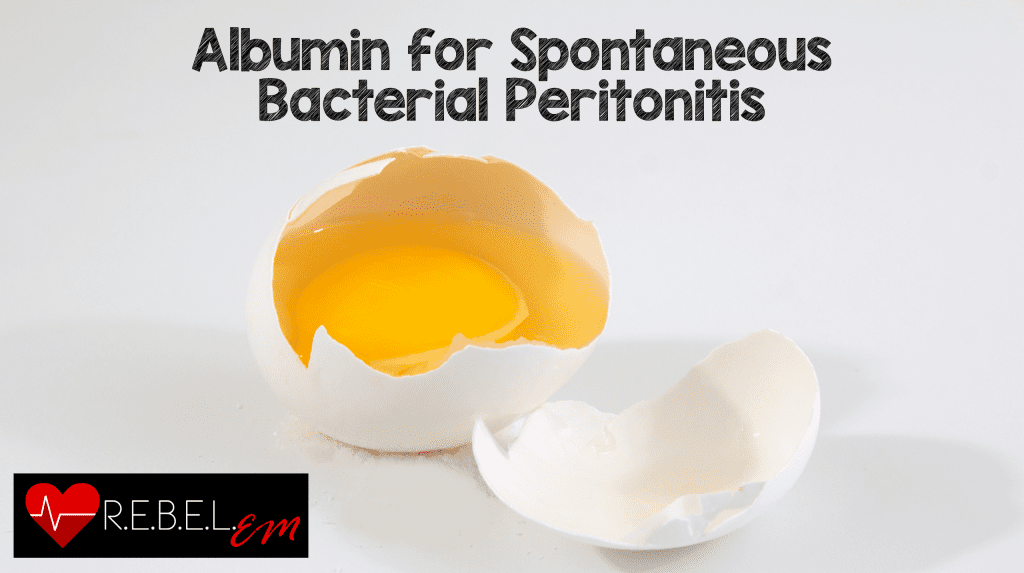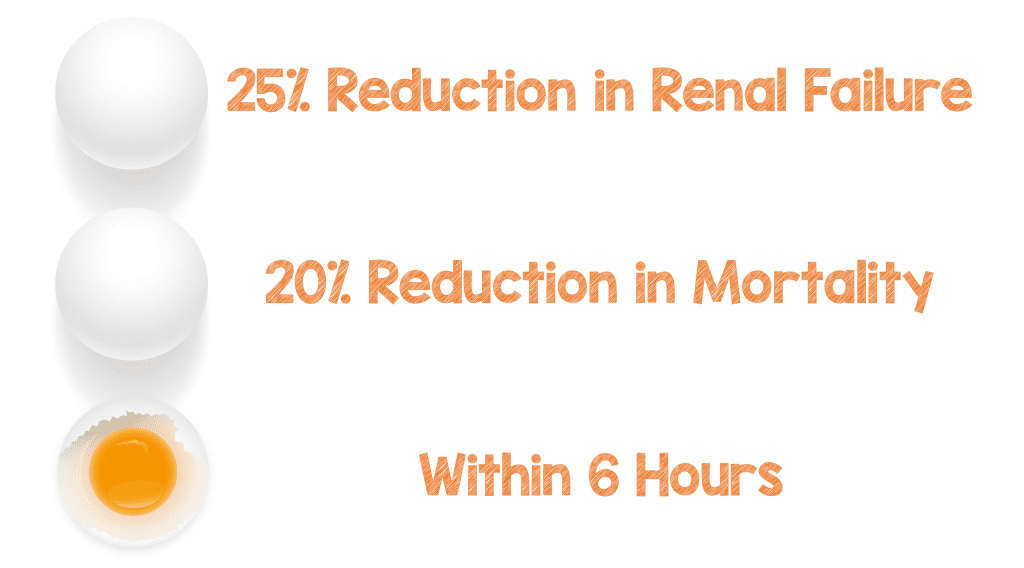
 The Background: Nearly 50% of patients in the U.S. with cirrhotic liver disease develop ascites over a 10-year period of observation, placing them at risk for developing spontaneous bacterial peritonitis (SBP) (Runyon 2012). It is estimated that 12-25% of patients with ascites in the ED will have spontaneous bacterial peritonitis (SBP) but the classic triad of fever, abdominal pain, and worsening ascites is often absent (Borzio 2001)(Runyon 1988). With a mortality rate approaching 40%, rapid diagnosis and evidence-based treatment is critical in the management of patients presenting with SBP (Salerno 2013).
The Background: Nearly 50% of patients in the U.S. with cirrhotic liver disease develop ascites over a 10-year period of observation, placing them at risk for developing spontaneous bacterial peritonitis (SBP) (Runyon 2012). It is estimated that 12-25% of patients with ascites in the ED will have spontaneous bacterial peritonitis (SBP) but the classic triad of fever, abdominal pain, and worsening ascites is often absent (Borzio 2001)(Runyon 1988). With a mortality rate approaching 40%, rapid diagnosis and evidence-based treatment is critical in the management of patients presenting with SBP (Salerno 2013).
SBP is diagnosed via cell count and differential of ascitic fluid obtained by paracentesis demonstrating an elevated polymorphonuclear leukocyte (PMN) count (≥ 250 cells/mm3). Treatment focuses on appropriate antibiotic therapy. A third-generation cephalosporin is the treatment of choice as they are typically effective in covering the three most common isolates from infected ascitic fluid: Escherichia coli, Klebsiella pneumonia, and Streptococcus pneumonia (Runyon 2012). Intravenous albumin administration is often added to the management of these patients but the utility for improving morbidity and mortality is questionable. The benefit of albumin infusion in SBP is not entirely known, although multiple possible mechanisms have been identified. Albumin has been demonstrated to mitigate endotoxemia, block lipopolysaccharide-stimulated neutrophil activity, and modulate nitric oxide activity, mitigating systemic vasodilation and capillary leak (Salerno 2013).
The Clinical Questions:
- What is the literature regarding the use of intravenous albumin in the treatment of spontaneous bacterial peritonitis?
- What relevant guidelines apply to the use of intravenous albumin in the treatment of SBP in the emergency department?
The Literature Search:
A PubMed and MEDLINE search was undertaken to identify randomized clinical trials examining the addition of albumin therapy to antibiotics in the treatment of spontaneous bacterial peritonitis. Inclusion was limited to those studies reporting patient-oriented outcomes. Systematic reviews and meta-analyses were studied to ensure consistency and thoroughness in data reporting (Narula 2011)(Jamtgaard 2016). Four RCTs were identified as applicable, however two trials included in previous reviews were excluded, as one used hydroxyethyl starch as the comparator (Fernandez 2005) and the other examined disease-oriented outcomes such as cytokine mitigation instead of the outcomes of interest (Chen 2009). Two RCTs were ultimately identified as appropriate for inclusion and review. Additionally the most recent guidelines from the American Association for the Study of Liver Diseases (AASLD) were reviewed.
The Data:
Study #1 Sort, et al. NEJM, 1999
- Methods: Multicenter, double-blinded RCT with co-primary outcomes of development of renal impairment or mortality at 90 days.
- Population: 126 inpatients diagnosed with SBP among seven university hospitals.
- Intervention: IV albumin 1.5g/kg given within 6 hours with an additional 1g/kg given on day 3 plus IV Cefotaxime.
- Controls: IV Cefotaxime alone.
- Outcome: IV albumin reduced the rate of renal failure (10% vs 33%, p=0.002) and in-hospital mortality (10% vs 29%, p=0.01).
- Limitations: Patients randomized to the Cefotaxime alone group were sicker (baseline serum bilirubin 6mg/dl vs 4mg/dl for the albumin group), and subgroup analyses of these data have shown benefit only in patients with more severe disease.
- Take Home Point: For select patients, the addition of IV albumin (1.5g/kg) given within 6 hours of diagnosis of SBP reduces the incidence of renal failure and in-hospital mortality in patients with
Study #2 Xue, et al. Chin J Dig Dis, 2002
- Methods: Single center, unblinded RCT with co-primary outcomes of development of renal impairment of mortality. Length of follow-up was not specified.
- Population: 112 inpatients diagnosed with SBP at one university hospital.
- Intervention: IV albumin 0.5–1.0 g/kg given within 6 hours of enrollment and with the same amount on the 3rd day, and then every 3 days plus IV ceftriaxone.
- Controls: IV ceftriaxone alone.
- Outcome: IV albumin reduced the rate of renal failure (9% vs 34%, p=0.002) and in-hospital mortality (9% vs 35%, p=0.01).
- Limitations: Baseline patient demographics were not reported, raising the possibility of selection bias and limiting confidence in the reported data.
- Take Home Point: The addition of intravenous albumin to an antibiotic regimen may reduce the incidence of renal impairment and mortality in cirrhotic patients with SBP.
The Guidelines:
The 2012 AASLD Guidelines, based largely on the trial by Sort, et al., recommend that patients with ascitic fluid PMN counts greater than or equal to 250 cells/mm3 and clinical suspicion of SBP, who also have a serum creatinine >1 mg/dL, blood urea nitrogen >30 mg/dL, or total bilirubin >4 mg/dL should receive IV albumin (1.5 g/kg) within 6 hours of detection and 1.0 g/kg on day 3. (Class IIa, Level B)i
The Takeaway:
The use of IV albumin in addition to antibiotics in the treatment of patients with SBP and concomitant azotemia or hyperbilirubinemia is a lifesaving intervention of critical importance in the emergency department. As the published data and AASLD recommend administration within six hours of diagnosis, this intervention falls firmly in the hands of ED providers.
The Recommendation:
We recommend timely administration of 1.5 g/kg of albumin in addition to antibiotics in all patients presenting to the emergency department diagnosed with SBP who also have a serum creatinine >1 mg/dL, BUN >30 mg/dL, or total bilirubin >4 mg/dL.

Guest Post By:

Rick Pescatore, DO
Assistant Director of Emergency Medicine Research
Inspira Health Network
Vineland, NJ
Twitter: @Rick_Pescatore
References:
- Runyon, Bruce A. “Introduction to the revised American Association for the Study of Liver Diseases Practice Guideline management of adult patients with ascites due to cirrhosis 2012.” Hepatology 57.4 (2013): 1651-1653. PMID: 23463403
- Borzio, M., et al. “Bacterial infection in patients with advanced cirrhosis: a multicentre prospective study.” Digestive and Liver Disease 33.1 (2001): 41-48. PMID: 11303974
- Runyon, Bruce A., John C. Hoefs, and Timothy R. Morgan. “Ascitic fluid analysis in malignancy‐related ascites.” Hepatology 8.5 (1988): 1104-1109. PMID 3417231
- Salerno, Francesco, Roberta J. Navickis, and Mahlon M. Wilkes. “Albumin infusion improves outcomes of patients with spontaneous bacterial peritonitis: a meta-analysis of randomized trials.” Clinical Gastroenterology and Hepatology 11.2 (2013): 123-130. PMID: 23178229
- Narula, Neeraj, Keith Tsoi, and John K. Marshall. “Should albumin be used in all patients with spontaneous bacterial peritonitis?” Canadian Journal of Gastroenterology and Hepatology 25.7 (2011): 373-376. PMID: 21876859
- Jamtgaard, Louis, Sara L. Manning, and Brian Cohn. “Does Albumin Infusion Reduce Renal Impairment and Mortality in Patients With Spontaneous Bacterial Peritonitis?” Annals of emergency medicine 67.4 (2016): 458-459. PMID: 26234193
- Fernández J, Monteagudo J, Bargallo X, et al. A randomized unblinded pilot study comparing albumin versus hydroxyethyl starch in spontaneous bacterial peritonitis. Hepatology 2005;42: 627– 634. PMID: 16108036
- Chen TA, Tsao YC, Chen A, et al. Effect of intravenous albumin on endotoxin removal, cytokines, and nitric oxide production in patients with cirrhosis and spontaneous bacterial peritonitis. Scand J Gastroenterol 2009;44:619 – 625. PMID: 19191184
- Sort, P., et al. “Intravenous albumin in patients with cirrhosis and spontaneous bacterial peritonitis.” N Engl J Med 1999.341 (1999): 1773-1774. PMID: 10432325
- Xue, Hui Ping, et al. “Effect of albumin infusion on preventing the deterioration of renal function in patients with spontaneous bacterial peritonitis.” Chinese Journal of Digestive Diseases 3.1 (2002): 32-34. DOI: 10.1046/j.1443-9573.2002.00062.x
Post Peer Reviewed By: Anand Swaminathan (Twitter: @EMSwami) and Salim Rezaie (Twitter: @srrezaie)
The post Should You Give Albumin in Spontaneous Bacterial Peritonitis (SBP)? appeared first on REBEL EM - Emergency Medicine Blog.
